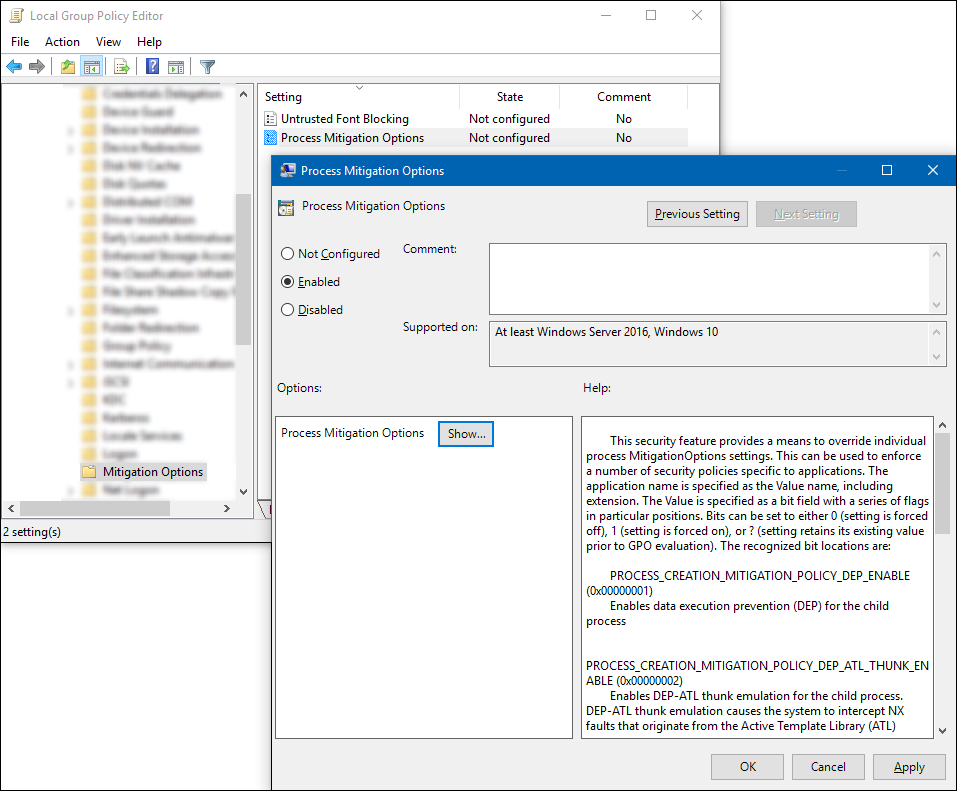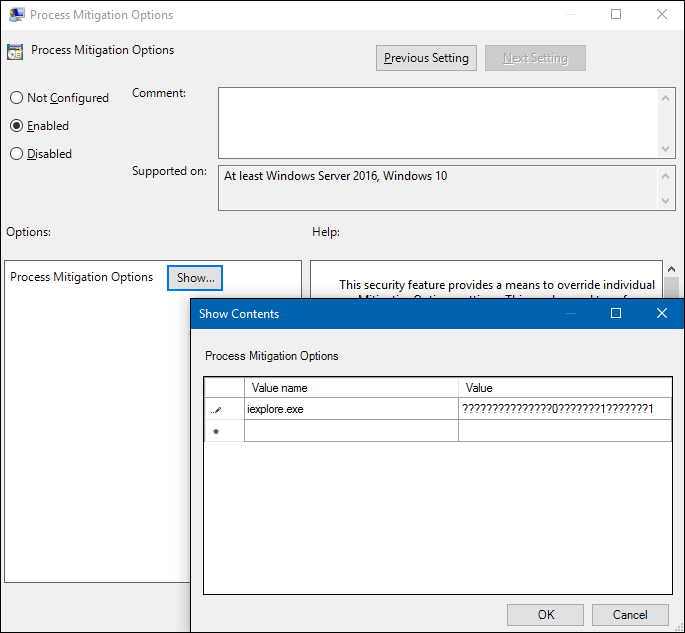Override Process Mitigation Options to help enforce app-related security policies
Windows includes group policy-configurable "Process Mitigation Options" that add advanced protections against memory-based attacks, that is, attacks where malware manipulates memory to gain control of a system. For example, malware might attempt to use buffer overruns to inject malicious executable code into memory, but Process Mitigation Options can prevent the running of the malicious code.
Important
We recommend trying these mitigations in a test lab before deploying to your organization, to determine if they interfere with your organization's required apps.
The Group Policy settings in this article are related to three types of process mitigations. All three types are on by default for 64-bit applications, but by using the Group Policy settings described in this article, you can configure more protections. The types of process mitigations are:
- Data Execution Prevention (DEP) is a system-level memory protection feature that enables the operating system to mark one or more pages of memory as nonexecutable, preventing code from being run from that region of memory, to help prevent exploitation of buffer overruns. DEP helps prevent code from being run from data pages such as the default heap, stacks, and memory pools. For more information, see Data Execution Prevention.
- Structured Exception Handling Overwrite Protection (SEHOP) is designed to block exploits that use the Structured Exception Handler (SEH) overwrite technique. Because this protection mechanism is provided at run-time, it helps to protect apps regardless of whether they're compiled with the latest improvements. For more information, see Structured Exception Handling Overwrite Protection.
- Address Space Layout Randomization (ASLR) loads DLLs into random memory addresses at boot time to mitigate against malware that's designed to attack specific memory locations, where specific DLLs are expected to be loaded. For more information, see Address Space Layout Randomization. To find more ASLR protections in the table below, look for
IMAGESorASLR.
The following procedure describes how to use Group Policy to override individual Process Mitigation Options settings.
To modify Process Mitigation Options
Open your Group Policy editor and go to the Administrative Templates\System\Mitigation Options\Process Mitigation Options setting.

Select Enabled, and then in the Options area, select Show to open the Show Contents box, where you can add your apps and the appropriate bit flag values, as shown in the Setting the bit field and Example sections of this article.
Important
For each app you want to include, you must include:
- Value name. The app file name, including the extension. For example,
iexplore.exe. - Value. A bit field with a series of bit flags in particular positions. Bits can be set to
0(where the setting is forced off),1(where the setting is forced on), or?(where the setting retains the previous, existing value). Setting bit flags in positions not specified here to anything other than?might cause undefined behavior.

- Value name. The app file name, including the extension. For example,
Setting the bit field
Here's a visual representation of the bit flag locations for the various Process Mitigation Options settings:

Where the bit flags are read from right to left and are defined as:
| Flag | Bit location | Setting | Details |
|---|---|---|---|
| A | 0 | PROCESS_CREATION_MITIGATION_POLICY_DEP_ENABLE (0x00000001) |
Turns on Data Execution Prevention (DEP) for child processes. |
| B | 1 | PROCESS_CREATION_MITIGATION_POLICY_DEP_ATL_THUNK_ENABLE (0x00000002) |
Turns on DEP-ATL thunk emulation for child processes. DEP-ATL thunk emulation lets the system intercept nonexecutable (NX) faults that originate from the Active Template Library (ATL) thunk layer, and then emulate and handle the instructions so the process can continue to run. |
| C | 2 | PROCESS_CREATION_MITIGATION_POLICY_SEHOP_ENABLE (0x00000004) |
Turns on Structured Exception Handler Overwrite Protection (SEHOP) for child processes. SEHOP helps to block exploits that use the Structured Exception Handler (SEH) overwrite technique. |
| D | 8 | PROCESS_CREATION_MITIGATION_POLICY_FORCE_RELOCATE_IMAGES_ALWAYS_ON (0x00000100) |
Uses the force Address Space Layout Randomization (ASLR) setting to act as though an image base collision happened at load time, forcibly rebasing images that aren't dynamic base compatible. Images without the base relocation section aren't loaded if relocations are required. |
| E | 15 | PROCESS_CREATION_MITIGATION_POLICY_BOTTOM_UP_ASLR_ALWAYS_ON (0x00010000) |
Turns on the bottom-up randomization policy, which includes stack randomization options and causes a random location to be used as the lowest user address. |
| F | 16 | PROCESS_CREATION_MITIGATION_POLICY_BOTTOM_UP_ASLR_ALWAYS_OFF (0x00020000) |
Turns off the bottom-up randomization policy, which includes stack randomization options and causes a random location to be used as the lowest user address. |
Example
If you want to turn on the PROCESS_CREATION_MITIGATION_POLICY_DEP_ENABLE and PROCESS_CREATION_MITIGATION_POLICY_FORCE_RELOCATE_IMAGES_ALWAYS_ON settings, turn off the PROCESS_CREATION_MITIGATION_POLICY_BOTTOM_UP_ASLR_ALWAYS_OFF setting, and leave everything else as the default values, you'd want to type a value of ???????????????0???????1???????1.